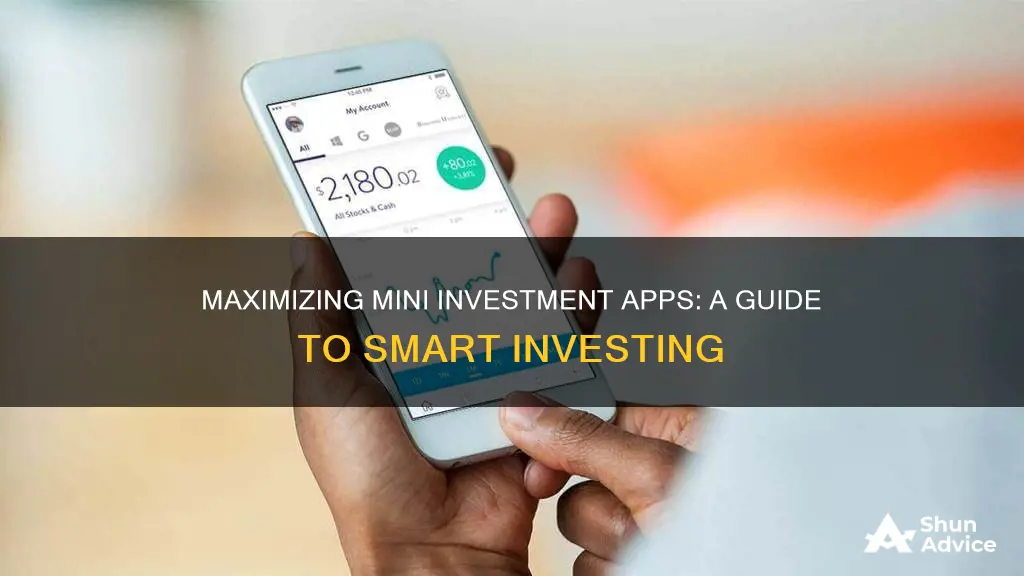
Micro-investing apps allow users to invest small amounts of money, often automatically. These apps are usually mobile-based platforms that let you make investments or check your account on the go. Micro-investing apps can either round up the dollar amounts on purchases made on a credit or debit card and divert the extra cash to an investment account, or divert extra change to a savings account.
When choosing a micro-investing app, it's important to consider the different forms, costs, registration, fees, and unintended charges. It's also crucial to ensure you are contributing to retirement and emergency funds through other investment and savings accounts.
- Acorns
- Betterment
- Stash
- Wealthfront
- Fidelity Investments
- Robinhood
- Stock Rover
- Charles Schwab
- Ellevest
- Public
- Fundrise
| Characteristics | Values |
|---|---|
| Accessibility | Mobile-based platforms |
| Investment Amounts | Small amounts |
| Investment Frequency | Frequent intervals |
| Investment Options | Stocks, bonds, ETFs, mutual funds, crypto, robo-advisors, etc. |
| Investment Style | Micro-investing, retirement-focused, tax-optimized, socially responsible, etc. |
| Fees | Monthly fees, trading fees, advisory fees, etc. |
| Account Types | Individual, joint, retirement, custodial, etc. |
| Tools & Resources | Educational content, market news, investment research, etc. |
| Security | Two-factor authentication, data encryption, account alerts, SIPC protection, etc. |
What You'll Learn

How to choose the right investment app for you
Choosing the right investment app is crucial, as it can help you manage your portfolio and buy or sell investments via your phone. Here are some factors to consider when selecting the best investment app for you:
- Investment goals: Determine your financial goals, time horizon, and risk tolerance. Are you saving for retirement, or do you have shorter-term objectives? Different apps cater to various goals, so choose one aligned with your targets.
- Investment options: Consider the range of investment options available on each app. Do you want to invest in stocks, bonds, ETFs, cryptocurrencies, or other alternative assets? Ensure the app provides access to the specific investments you're interested in.
- Account fees: Evaluate the app's fee structure, including monthly or annual account fees, transaction fees, and trading fees. If you're an active trader, apps with minimal or no fees will be more cost-effective.
- Minimum deposit: If you're new to investing or prefer a smaller initial investment, look for apps with low or no minimum deposit requirements. This gives you flexibility in how much you want to invest upfront.
- Mobile app rating: If you plan to invest primarily through your mobile device, opt for an app with a high rating and positive user reviews. A well-rated app will likely provide a smoother and more intuitive user experience.
- Educational resources: If you're a beginner, educational tools and webinars can be invaluable. Look for apps that offer articles, webinars, or other resources to help you make more informed investment decisions.
- Customer service: Consider the customer support options offered. If you prefer speaking to a human, ensure the app provides phone or chat support. Email-only customer service may not be sufficient for time-sensitive queries.
- Integrations: Explore whether the app integrates with other tools you use, such as bank accounts or tax software. This can streamline your financial management, especially during tax season.
- Fractional shares: Fractional shares allow you to buy a partial slice of a company's stock, rather than purchasing a full share. This feature lets you invest in companies that might otherwise be out of your budget.
- Security: Check the app's security features, such as biometric logins, encryption protocols, and two-factor authentication. Also, review its track record for any security breaches.
- Account type: Choose the type of account that aligns with your financial goals and investment strategy. Common options include individual brokerage accounts, Roth IRAs, traditional IRAs, and custodial accounts for investing on behalf of a child.
Remember, the best investment app for you will depend on your unique needs, goals, and investment strategy. Compare different apps based on these factors and consider testing out a few before committing to one.
GE: Investing in Technology for Future Success
You may want to see also

How to set up your account
Setting up an account with a micro-investing app is a straightforward process. Here's a step-by-step guide:
Choose an App
The first step is to select a micro-investing app that suits your needs and preferences. Popular options include Acorns, Stash, and Robinhood. Compare factors such as account fees, investment choices, and ease of use to make an informed decision.
Sign Up and Set Up Your Account
Once you've chosen an app, download it on your device. You'll need to provide personal information, such as your name, email address, and phone number. Some apps may also ask for additional details like your investment goals and risk tolerance. This information helps the app tailor its recommendations to your profile.
Link Your Bank Account
To fund your investments, you'll need to link your bank account to the app. This usually involves providing your bank account and routing numbers. Make sure you have this information handy during the sign-up process.
Fund Your Account
Decide on the amount you want to invest initially and transfer funds from your bank account to your investment app. This is also an excellent time to set up automatic recurring contributions. You can choose to invest a fixed amount weekly, biweekly, or monthly, making it easier to stick to your investment plan.
Explore Investment Options
Most micro-investing apps offer a range of investment options, including stocks, bonds, exchange-traded funds (ETFs), and mutual funds. Take some time to research these options and understand the risks and potential returns associated with each. Utilise any educational resources or articles within the app to enhance your investment knowledge.
Build Your Portfolio
Now comes the exciting part—choosing your investments! Select investments that align with your financial goals, risk tolerance, and investment horizon (short-term vs. long-term). Diversification is key, so spread your investments across different asset classes to minimise risk.
Monitor Your Portfolio
Regularly check in on your investments to track their performance. Most apps provide tools to help you monitor your progress and make adjustments as needed. Remember that investing involves risk, so only invest what you can afford to lose.
Chase You Invest: A Comprehensive Guide to Getting Started
You may want to see also

How to fund your account
Once you've chosen an investment app, you'll need to download it and sign up. This usually involves providing personal information such as your name, address, and bank details. After signing up, you'll need to link your bank account to the investment app and transfer funds.
- Decide how much you want to invest: This will depend on your financial situation and goals. There is usually no minimum balance required, and you can start investing with just a few dollars.
- Transfer funds from your bank: Decide on the amount you want to invest and transfer funds from your bank account to your investment app. You can set up automatic recurring contributions to invest on a weekly, biweekly, or monthly basis.
- Explore investment options: Research the different investment options available on the app, such as stocks, bonds, ETFs, and mutual funds. Utilize any educational resources or articles within the app to grow your knowledge.
- Choose your investments: Select investments that align with your goals, budget, risk tolerance, and investment horizon. Consider diversifying your portfolio to spread your risk.
- Monitor your investments: Keep track of your investments' performance and make adjustments as needed. Remember that investing involves risk, so don't invest more than you can afford to lose.
It's important to note that the specific steps may vary depending on the investment app you choose. Be sure to review the app's instructions and guidelines for funding your account.
Depreciation's Impact on Cash Flow: Investing Activities
You may want to see also

How to explore investment options
Exploring investment options is an important step in your investment journey. Here are some tips on how to explore investment options, especially when using mini investment apps:
- Understand your investment goals: Before exploring specific investment options, it's crucial to identify your investment goals and risk tolerance. Are you investing for retirement, saving for a down payment on a house, or looking for short-term gains? Different investment options will align better with different goals. For example, if you're saving for retirement, you might want to focus on tax-efficient investments like retirement accounts. On the other hand, if you're comfortable with higher risk, you might explore options like stocks or cryptocurrencies.
- Research and compare different investment options: There are numerous investment options available, including stocks, bonds, exchange-traded funds (ETFs), mutual funds, real estate, and more. Research each option to understand how it works, its potential risks and rewards, and how it aligns with your goals. Compare different investment options to identify those that best match your criteria.
- Consider your investment horizon: Your investment horizon refers to the length of time you plan to hold an investment. Some investments are better suited for long-term goals, while others may be more appropriate for short-term gains. For example, stocks and mutual funds are typically considered long-term investments, while options and futures contracts are often used for short-term speculation.
- Evaluate fees and costs: Investment apps and different investment options come with various fees and costs that can eat into your returns. Be sure to understand the fee structure of each investment option you're considering. Compare management fees, transaction fees, and any other associated costs to make an informed decision.
- Diversify your portfolio: Diversification is a key aspect of successful investing. By spreading your investments across various asset classes, sectors, and geographic regions, you reduce the risk of losing all your money in a single investment. Diversification also helps smooth out the ups and downs of the market, providing a more stable long-term growth trajectory.
- Utilize the features of mini investment apps: Many mini investment apps offer tools and resources to help you explore investment options. These may include educational content, investment screeners, and portfolio analysis tools. Take advantage of these features to expand your investment knowledge and make more informed decisions.
- Start with small investments: Mini investment apps often allow you to start with small amounts of money. This gives you a risk-free way to explore different investment options and gain firsthand experience in the market. You can start by investing in a diverse range of options and gradually increase your investments as you become more confident.
- Seek professional guidance: If you're unsure where to start or need more personalized advice, consider consulting a financial advisor or a robo-advisor. They can provide guidance based on your financial situation, goals, and risk tolerance. Robo-advisors, in particular, offer low-cost, automated investment management services that can build and manage a portfolio for you.
Schwab's Cash Investment Options: What You Need to Know
You may want to see also

How to monitor your portfolio
Monitoring your portfolio is a crucial part of investing, and there are many apps that can help you do this effectively. Here are some tips on how to monitor your portfolio using mini investment apps:
- Keep yourself updated on the latest news about the company: Political, social, and economic events can all impact a company's performance, so it's important to stay informed. Be sure to also keep an eye out for any company announcements, as these can indicate the direction the company is heading in.
- Analyze the company's quarterly results: Assess the financial performance of the company by reviewing their quarterly financial reports. While there may be losses one quarter and profits the next, try to understand the bigger picture and the potential of the company.
- Keep track of any changes in the shareholding pattern: Compare the shareholding pattern of the company over different quarters to see if promoters are increasing or decreasing their stakes. This can indicate the potential for growth or potential roadblocks.
- Check the credit rating of the company: Like individuals, companies also have credit ratings. A poor credit rating can be a red flag, indicating that the company may not be managing its debts efficiently.
- Monitor the stock price: While this shouldn't be your only method of monitoring, it can be a quick way to gauge the performance of your stocks. Just be sure to keep emotions in check and avoid making impulsive decisions based on price movements.
- Assess the promoter's pledge of shares: Keep an eye on the promoter's pledge of shares, as this can be one of the first signs of financial trouble in a company. If the promoter cannot repay loans, lenders may sell the shares, causing a negative impact on the share price.
- Utilize a portfolio tracker app: Apps like Empower (formerly Personal Capital), SigFig Wealth Management, Sharesight, and Yahoo Finance offer real-time information on your investments, including stocks, bonds, mutual funds, and retirement accounts. These apps can sync with your existing accounts and provide easy-to-read graphs and charts to help you monitor your portfolio's performance.
- Consider a brokerage app: If you have a simple portfolio or don't want to link multiple accounts to a portfolio tracker app, you may prefer to use your brokerage's app to monitor your investments. Many brokerages offer apps with portfolio tracking features, such as M1 Finance and Fidelity.
Positive Cash Flows: A Smart Investment Strategy?
You may want to see also
Frequently asked questions
The right investment app for you will depend on your unique mix of needs, goals and timeframe. Consider the app's usability, fees, investment menu, trading ability and educational materials. For example, if you're a beginner, you'll want an app with low fees and generous educational resources.
First, choose an investment app that suits your investment style and needs. Then, download the app and sign up, providing any necessary personal information. After that, link your bank account, debit card or credit card to the app and transfer money to your investment account.
Most investments are accessible through mobile apps, but the selection varies among brokers. Traditional brokers typically offer the widest range of options, including stocks, bonds, mutual funds, ETFs, options and cryptocurrencies.







